 Backend Development
Backend Development
 Golang
Golang
 An article to help you understand the basic functions of Go language (Part 2)
An article to help you understand the basic functions of Go language (Part 2)
An article to help you understand the basic functions of Go language (Part 2)
Go function memory allocation diagram
Go's function memory allocation is a bit like heap allocation, but it is not essentially the same.
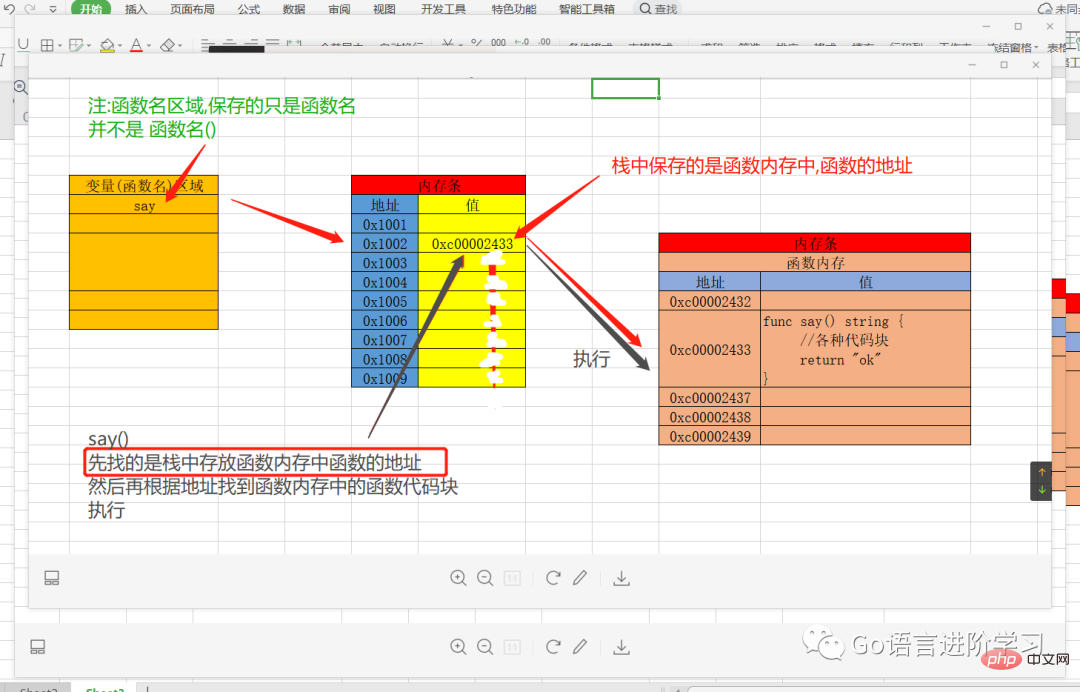
It can be understood that like heap memory, the stack stores the address of the heap.
Verification
Code
package main
import "fmt"
func say() string {
return "ok"
}
func main() {
fmt.Printf("say栈上的内容:%p\n",say)
}Result

Essence
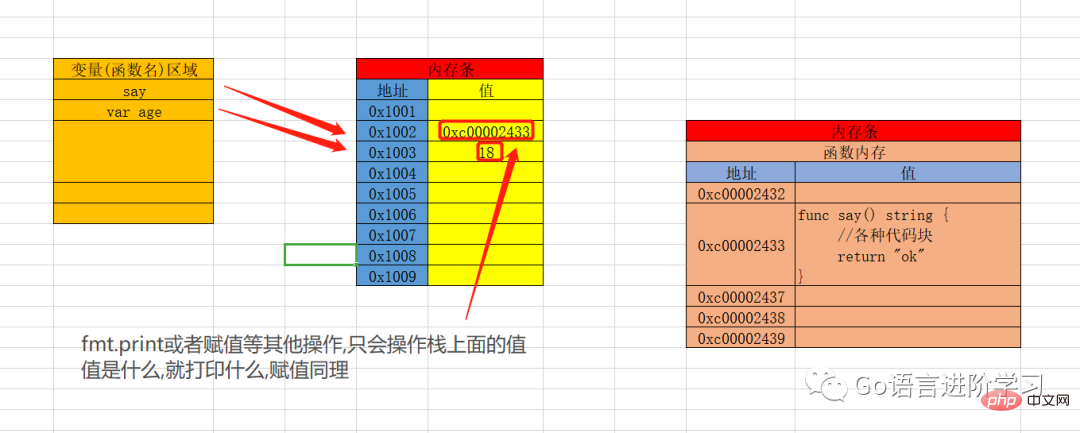
function Scope
#The issue of scope may have been raised more or less before, so let’s review it again.
Global variables
Global variables are variables defined outside all functions. The variables will always exist until the program ends.
当然,任何函数都可以访问全局变量。
注:全局变量尽量全部用大写。
小试牛刀
package main
import "fmt"
var NAME = "张三"
func say() string {
fmt.Println(NAME)
return "ok"
}
func main() {
say()
fmt.Println(NAME)
}结果:
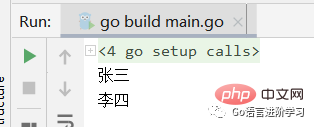
上述可能会有个问题,全局变量,全局变量,大家共用一个,要是谁傻不拉几修改了不就完蛋了,整个程序都凉了。
var引发的问题
就像这样。
package main
import "fmt"
var NAME = "张三"
func say() string {
fmt.Println(NAME)
NAME = "李四"
return "ok"
}
func main() {
say()
fmt.Println(NAME)
}结果:
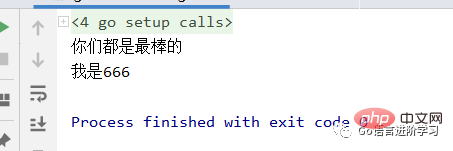
这不就完犊子了吗???所以,一定要有解决办法。
使用const解决问题
解决办法:使用常量定义全局变量。
package main
import "fmt"
const NAME = "张三"
func say() string {
fmt.Println(NAME)
//NAME = "李四"//会报错:cannot assign to NAME
return "ok"
}
func main() {
say()
fmt.Println(NAME)
}总结
在定义全局变量时,需要用const修饰,并且变量名全部大写。
局部变量
局部变量,局部变量就是在某个函数内定义的变量,只能在自己函数内使用。
更专业点,在{}内定义的,只能在{}内使用,for同理。
代码
package main
import (
"fmt"
)
func say() string {
var name = "张三"
fmt.Println(name)
return "ok"
}
func main() {
say()
//fmt.Println(name)//会报错:undefined: name
//for同理
for i := 0; i <= 1; i++ {
var c = "66"
fmt.Println(c) //66
}
//fmt.Println(c)//会报错:undefined: c
}defer
在Go中,defer语句,可以理解为在return之前执行的一个语句。
如果函数没有return,会有一个默认的return,只是看不见而已。
一个defer
代码
package main
import "fmt"
func say() {
//defer尽量往前放
defer fmt.Println("我是666")
fmt.Println("你们都是最棒的")
}
func main() {
say()
}执行结果

多个defer
代码
package main
import "fmt"
func say() {
//defer尽量往前放
defer fmt.Println(1)
defer fmt.Println(2)
defer fmt.Println(3)
fmt.Println("你们都是最棒的")
}
func main() {
say()
}执行结果

可以发现,defer的执行结果是反着的。
结论:最先执行的defer,会最后执行,最后执行的defer,会最先执行,有点像栈,先进后出。
defer的作用
通常来说,defer会用在释放数据库连接,关闭文件等需要在函数结束时处理的操作。
这里暂时先不举例子。
panic和recover
这俩,可以理解为Python中的try和raise,因为在Go中,是没有try的,是不能像其他语言一样,try所有异常。
应用场景:比如某个web,在启动时,数据库都没连接成功,必定要启动失败,就像电脑,没有电源必不能开机一样。
panic
先看一下语法吧
package main
import "fmt"
func say() {
var flag = true
if flag{
//引发错误,直接中断程序的错误
panic("OMG,撤了撤了,必须撤了")
}
}
func main() {
say()
fmt.Println("继续呀...")//不会执行,程序挂了
}执行效果
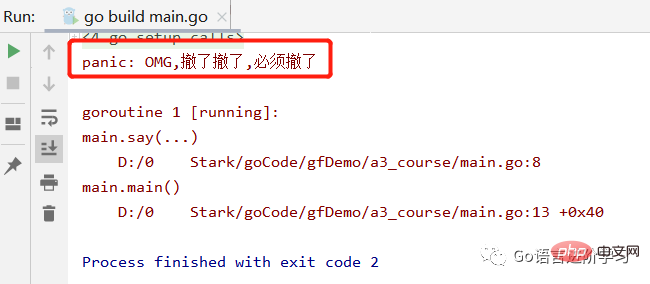
可以看淡,继续呀就没打印,程序直接挂了,但是上述好像并没有解决这个问题。
recover
尝试捕捉
代码
package main
import "fmt"
func say() {
//匿名函数,defer执行的是一个匿名函数
defer func() {
var err = recover()
//如果有panic错误,err!=nil,在此处步骤,尝试恢复
if err != nil {
fmt.Println("尝试恢复...")
}
}()
var flag = true
if flag {
panic("OMG,撤了撤了,必须撤了")
}
}
func main() {
say()
fmt.Println("继续呀...")
}执行结果
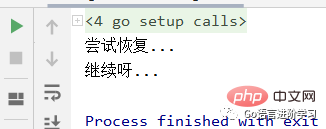
可以看到,如果recover捕捉了,并且没有panic,程序就会继续正常执行。
注意
defer必须在panic语句之前。
recover必须配合defer使用。
The above is the detailed content of An article to help you understand the basic functions of Go language (Part 2). For more information, please follow other related articles on the PHP Chinese website!

Hot AI Tools

Undresser.AI Undress
AI-powered app for creating realistic nude photos

AI Clothes Remover
Online AI tool for removing clothes from photos.

Undress AI Tool
Undress images for free

Clothoff.io
AI clothes remover

Video Face Swap
Swap faces in any video effortlessly with our completely free AI face swap tool!

Hot Article

Hot Tools

Notepad++7.3.1
Easy-to-use and free code editor

SublimeText3 Chinese version
Chinese version, very easy to use

Zend Studio 13.0.1
Powerful PHP integrated development environment

Dreamweaver CS6
Visual web development tools

SublimeText3 Mac version
God-level code editing software (SublimeText3)

Hot Topics
 1386
1386
 52
52
 What is the problem with Queue thread in Go's crawler Colly?
Apr 02, 2025 pm 02:09 PM
What is the problem with Queue thread in Go's crawler Colly?
Apr 02, 2025 pm 02:09 PM
Queue threading problem in Go crawler Colly explores the problem of using the Colly crawler library in Go language, developers often encounter problems with threads and request queues. �...
 What libraries are used for floating point number operations in Go?
Apr 02, 2025 pm 02:06 PM
What libraries are used for floating point number operations in Go?
Apr 02, 2025 pm 02:06 PM
The library used for floating-point number operation in Go language introduces how to ensure the accuracy is...
 How to solve the user_id type conversion problem when using Redis Stream to implement message queues in Go language?
Apr 02, 2025 pm 04:54 PM
How to solve the user_id type conversion problem when using Redis Stream to implement message queues in Go language?
Apr 02, 2025 pm 04:54 PM
The problem of using RedisStream to implement message queues in Go language is using Go language and Redis...
 In Go, why does printing strings with Println and string() functions have different effects?
Apr 02, 2025 pm 02:03 PM
In Go, why does printing strings with Println and string() functions have different effects?
Apr 02, 2025 pm 02:03 PM
The difference between string printing in Go language: The difference in the effect of using Println and string() functions is in Go...
 What should I do if the custom structure labels in GoLand are not displayed?
Apr 02, 2025 pm 05:09 PM
What should I do if the custom structure labels in GoLand are not displayed?
Apr 02, 2025 pm 05:09 PM
What should I do if the custom structure labels in GoLand are not displayed? When using GoLand for Go language development, many developers will encounter custom structure tags...
 What is the difference between `var` and `type` keyword definition structure in Go language?
Apr 02, 2025 pm 12:57 PM
What is the difference between `var` and `type` keyword definition structure in Go language?
Apr 02, 2025 pm 12:57 PM
Two ways to define structures in Go language: the difference between var and type keywords. When defining structures, Go language often sees two different ways of writing: First...
 Which libraries in Go are developed by large companies or provided by well-known open source projects?
Apr 02, 2025 pm 04:12 PM
Which libraries in Go are developed by large companies or provided by well-known open source projects?
Apr 02, 2025 pm 04:12 PM
Which libraries in Go are developed by large companies or well-known open source projects? When programming in Go, developers often encounter some common needs, ...
 When using sql.Open, why does not report an error when DSN passes empty?
Apr 02, 2025 pm 12:54 PM
When using sql.Open, why does not report an error when DSN passes empty?
Apr 02, 2025 pm 12:54 PM
When using sql.Open, why doesn’t the DSN report an error? In Go language, sql.Open...



